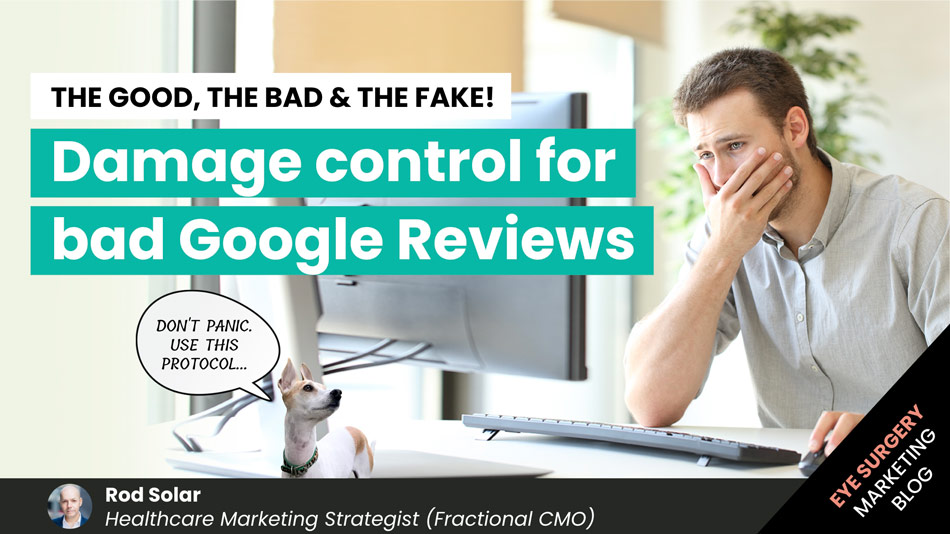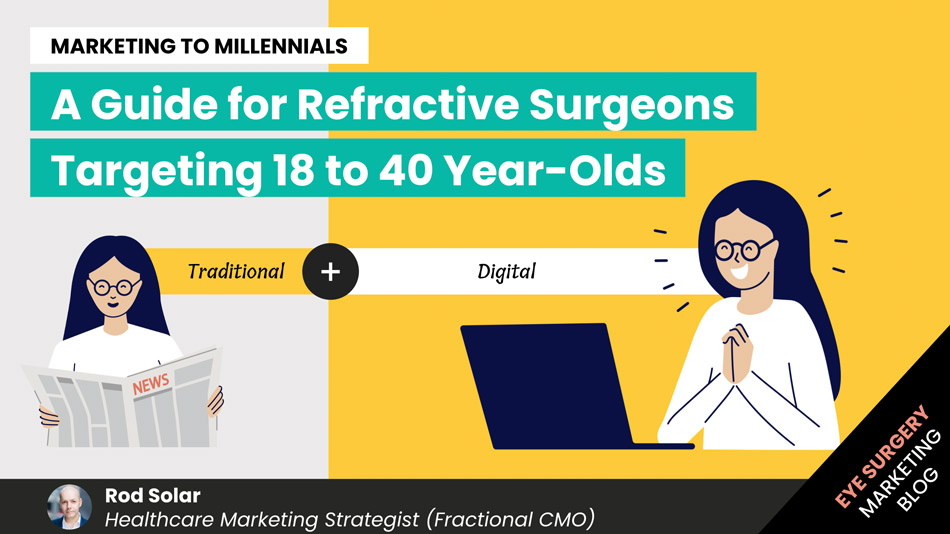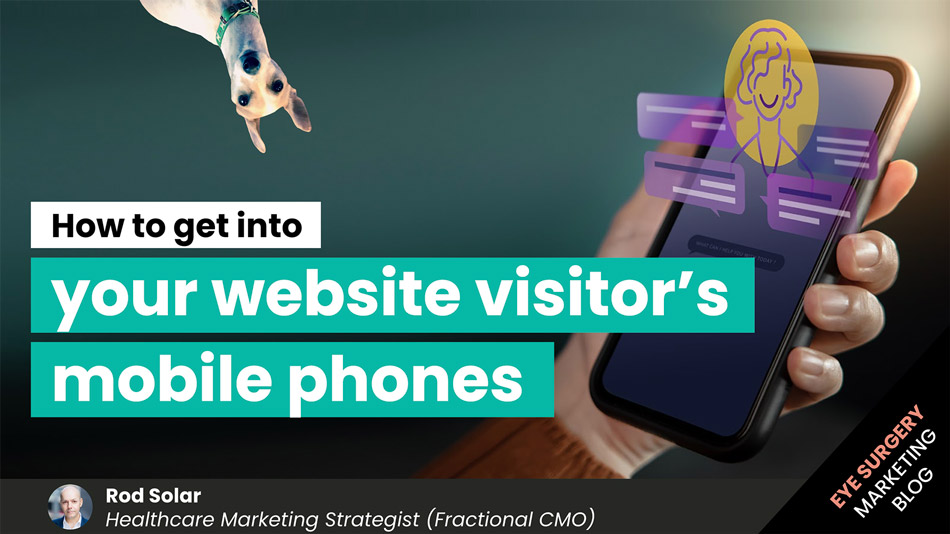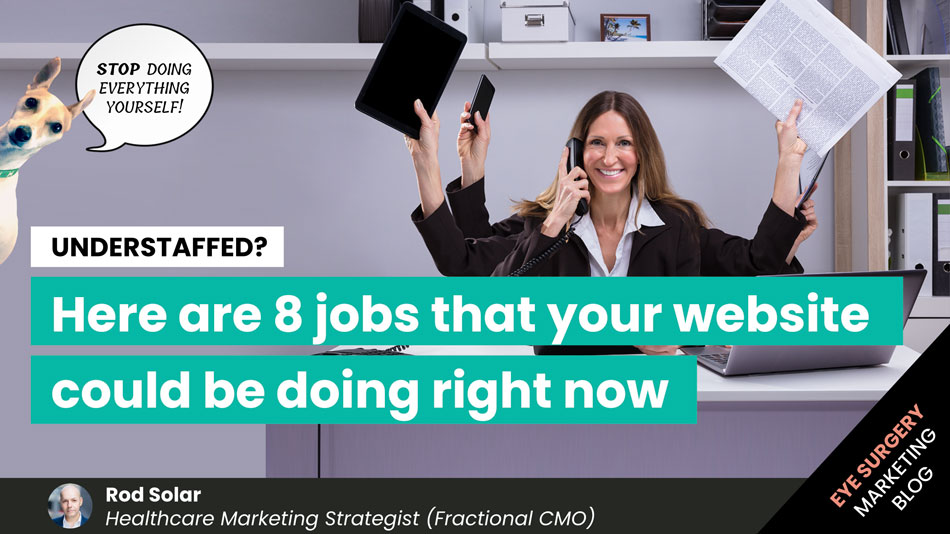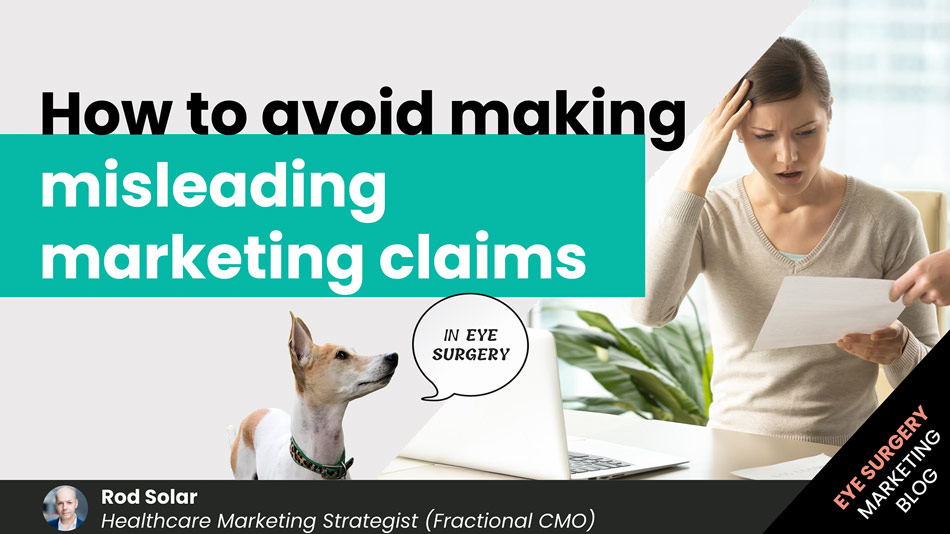
How to avoid making misleading marketing claims in eye surgery
It is a widely accepted fact that you must back up your marketing claims with evidence. This however, does not always happen in practice.
Unpacking the tension between marketing and “truth”
Most refractive surgeons (and the marketing agencies that work for them) know that they want to share messaging with potential patients that is some version of “we’re the best choice”. However, many are not aware of the extent to which they can back up these marketing claims. An issue that many practices fear is that they risk breaking the law or causing harm to their reputation by making unsubstantiated statements.
This guide will provide you with information on what types of claims you have at your disposal to ensure that your marketing stays within the bounds of credibility. I further discuss the kinds of claims we typically observe in refractive and cataract surgery marketing. I will also share a summary of the top-line regulations. Next, I’ll discuss what constitutes an acceptable level of substantiation for your marketing claims. Finally, I’ll end with some pointers on how best to present your claims so that they remain within legal limits while still being interesting and engaging for your audience.
Importantly, I’m not a lawyer, and this article does not constitute legal advice.
So, if you have a question about what constitutes an unsubstantiated claim, I recommend you consult with your legal counsel. Take note that regulations may differ in your country and may change by the time you read this post.
What is an advertising claim?
An advertising claim is any assertion you make about your organisation, brand, or product—across any channel.
Advertisers make claims related to different aspects of practice, including:
- Success outcomes and results
- Surgical safety and effectiveness
- Superior expertise or skill
- Social proof
- Superior technology
Advertisers also make claims related to personal attributes, which can also fall foul of some regulations.
If you make an objective statement about your product or service (i.e. refractive surgery) in any communications medium you control, you will need to prove it.
If your claim is in your advertisement, on your website, social media, brochures or letters, or comes out of the mouths of your staff, then that is an express claim.
The FTC further distinguishes between express and explicit claims. As the term suggests, implied claims are implicit, whereas express claims are explicit.
Puffery, or subjective claims, are outside the scope of regulation – at least in the US. While I’m not directly familiar with the laws regarding puffery in other countries, my experience suggests that they are more strict.
Types of advertising claims
1.Claims related to success outcomes and results
An example of an express claim is when Focus claims they are “London’s Only Clinic with 100% 20/20 Vision Success Rate”, in this ad:

If an advertiser (i.e. Focus Clinics in London) makes an express claim in this ad, then it is reasonable to expect that they would be able to furnish proof upon request for evidence supporting the claim.
First of all, are they the “only” clinic to have a 100% success rate? They’d have to provide evidence of this, however I believe that wouldn’t be hard to do as I’ve not seen this claim anywhere else. To give them the benefit of the doubt, I called them and asked to see the publication. They directed me to this page: Focus Clinics Is The Only Clinic With 100% Success Rate where they provide further information about a cohort study of 676 primary treatments.
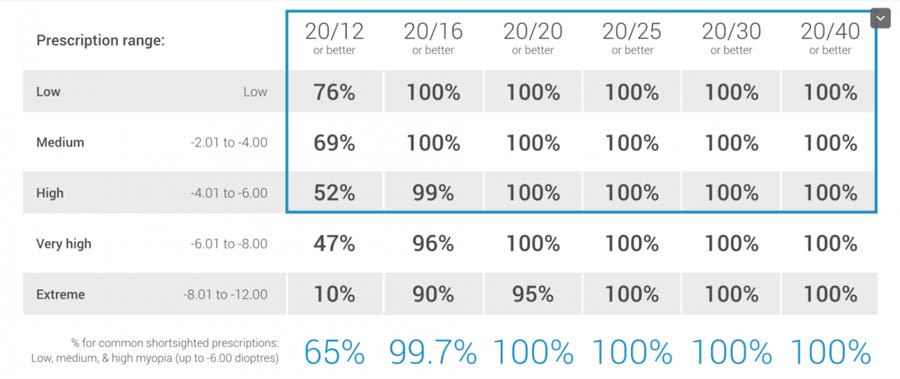
They are indeed good results. I commend them for auditing their results too. To the best of my knowledge, It’s more than most surgeons and clinics do. Upon close inspection, they make it clear that they qualify their claim by limiting the sample to myopes up to -6.00 diopters. A footnote on the page says, “You can click see (sic) our published results in the peer-review (sic) medical journal”. However, I can’t find the link to click. Barring the missing link, this claim has some evidence behind it, but it would be more credible if the link worked.
A competitor to Focus, London Vision Clinic also makes claims about their results. For example, they include this text on their results page:
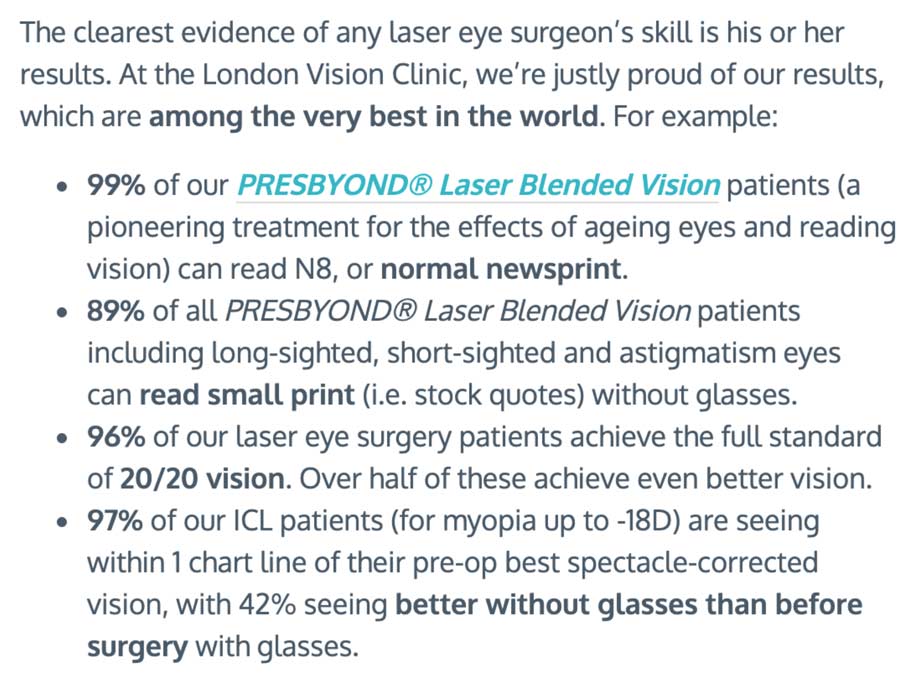
On their face, these results are not as impressive as Focus’s claims (i.e.100%). However, London Vision Clinic includes myopes up to -12.50 in their sample. Furthermore, they back up their results with references to 175 (and counting) peer reviewed publications with links to each.
Optegra’s claim would benefit from evidence (that the advertiser could add as a footnote that leads to a source for the statistic). So to give them the benefit of the doubt, I called Optegra Patient Services to ask for a link to a study. They told me they’d send it to me by email. I made the call on 11/11/2021. We published this post 7 days later and I still haven’t received the email.
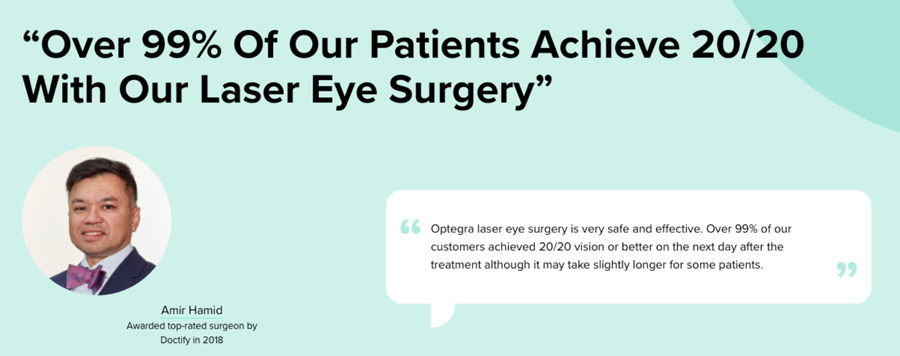
(NOTE: Want to see how your practice marketing measures up against the best in class? Take this 5-minute quiz to see how you stack up in the 9 areas of practice marketing and get specific tips and advice on how you can improve your weak points and better leverage your strengths).
2. Claims related to surgical safety and effectiveness
Safety and effectiveness claims tend to be implicit. So, let’s take a closer look at implied claims. An implied claim is one made indirectly or by inference, e.g. “ABC Mouthwash kills the germs that cause colds” contains an implied claim that the product will prevent colds.
For example, this excerpt from OCL Vision based in London (for context, see this link) is an implied claim about LASIK safety. I would assume that over 20% of people reading this claim would interpret it to suggest that LASIK is a safe procedure for them to have:

As an advertiser of refractive surgery, you will need to prove both success related and surgical safety claims.
Fortunately, refractive surgeons around the world can use the 2006 LASIK guidance from the UK’s National Institute for Health and Clinical Excellence (NICE). That document includes the material claim that “current evidence suggests that photorefractive (laser) surgery for the correction of refractive errors is safe and efficacious for use in selected patients.”
Importantly, marketers should be aware that efficacy is distinct from effectiveness. ClinMed explains the differences like this:
Efficacy, in the health care sector, is the capacity of a given intervention under ideal or controlled conditions. Effectiveness is the ability of an intervention to have a meaningful effect on patients in normal clinical conditions.
Thus, it might be a stretch to interpret the NICE guidance as evidence of the clinical effectiveness of laser eye surgery.
Another common claim refractive surgery advertisers make is that most patients are satisfied with LASIK surgery. A substantive reference for this claim are the results of the Federal Drug Administration (FDA)’s LASIK Quality of Life Collaboration Project, which found:
- More than 95% of participants were satisfied with their vision following LASIK surgery.
However, advertisers should be aware that a closer look at the study results paints a more nuanced picture.
Be careful, also, with claiming that most refractive surgery patients would recommend their choice to a friend or family member (especially when comparing against contact lens wearers). While verifiably true, one researcher published a study that examined the Net Promoter Score for vision correction. The Net Promoter Score question asks consumers “how likely are you to recommend [company brand or product] to a friend or family member?”
Surprisingly, “this pilot study found that soft contact lens wearers (n=38) are the most (76%) and spectacles wearers (n=35) are the least likely (29%) to recommend their modality to a friend or colleague. The study found that vision surgery correction patients (n=16) were highly likely (64%) to recommend, but not as much as contact lens wearers. I encourage researchers with an interest in this topic to pursue further research with larger sample sizes.
You may instead want to cite a larger study, published in the Journal of Refractive Surgery by Mitchell C. Brown, OD; Steven C. Schallhorn, MD; Keith A. Hettinger, MS, MBA; Stephanie E. Malady, BSMitchell C. Brown, OD. The researchers concluded “Patients report a high level of satisfaction with laser vision correction performed by a large corporate provider” in a paper called: “Satisfaction of 13,655 patients with laser vision correction at 1 month after surgery”.
A world literature review aimed at analyzing patient reported outcomes of satisfaction after LASIK found a similar conclusion to the FDA study:
An average 95.4% of patients were satisfied with their outcome after LASIK surgery. With 16.3 million procedures performed worldwide, and more than a decade of clinical studies and technological innovation, LASIK surgery should be considered among the most successful elective procedures. LASIK surgery compares more favorably with other elective surgical procedures in terms of generally higher satisfaction rates.
3. Claims related to superior expertise or skill
There is one more type of explicit claim, known as a “subjective claim”. This type of claim is also known as puffery. Because there is no “surgeon league-table”, most claims related to expertise are subjective.
In the US at least, subjective claims need no verification. The FTC considers opinions as separate from claims of fact. For example, “the world’s best” is just an opinion and not something that needs to be proven.
This ad contains an example of a subjective claim:

In this example, the advertiser claims that they are “California’s #1 LASIK surgeon”. That sounds impressive.
I visited the website the ad led to and found no attempt to justify this claim with evidence. The FTC (under which this advertisement is regulated) would suggest that they don’t need to.
On the same site, I did, however, find more subjective claims that, in my opinion, blur the line between objectivity and misdirection.
For example, I found this claim on the home page:

In this excerpt, the advertiser suggests that they are “The only LASIK expert”. That claim is nothing short of puffery. As one can read in the paragraph following the heading, he further qualifies the claim to suggest that he is the only LASIK expert in his practice.
Another example of puffery is this advertising copy on a Google Ad that suggests that Manhattan LASIK Center is the only center to offer the “The World’s Safest LASIK”. If their assertion is true, I would want to see evidence for this claim.

The page to which that ad leads (see screenshot below) doesn’t mention safety at all.
However, the landing page does suggest that Manhattan LASIK Center is both “the Nation’s Pioneer in LASIK & SMILE” and that they have the “Nation’s most experienced LASIK and SMILE surgeons.”
They do not provide evidence for either claim.
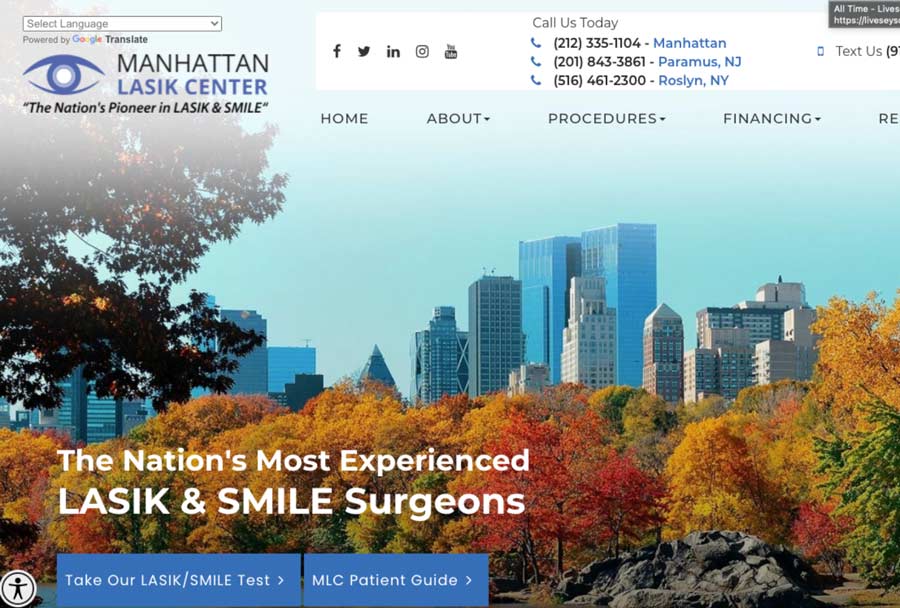
Ethics are beyond the scope of this post. However, it’s important to note that because doctors and surgeons still hold the power of authority, some consumers may believe that the subjective advertising claims they make are true on their face.
This type of practice can potentially lead to an erosion of trust in refractive surgery advertising claims that will negatively impact all refractive surgeons.
4. Claims related to social proof
Australia’s AHPRA advertising guidelines are broadly similar to the ones provided by the UK’s Advertising Standards Authority (ASA). However, they go a step further and advise on how health practitioners in Australia can use testimonials:
“You can’t use feedback or reviews from patients that include a clinical aspect of a regulated health service in your advertising.”
A clinical aspect exists in a testimonial if one of the following is expressed:
- Symptom – the specific symptom or the reason for seeking treatment
- Diagnosis or treatment – the specific diagnosis or treatment provided by the practitioner.
- Outcome – the specific outcome or the skills or experience of the practitioner either directly or via comparison.”
What that means is that Australian surgeons would not be allowed to use the type of testimonials you might commonly find in UK and US refractive surgery marketing, like the one below. :
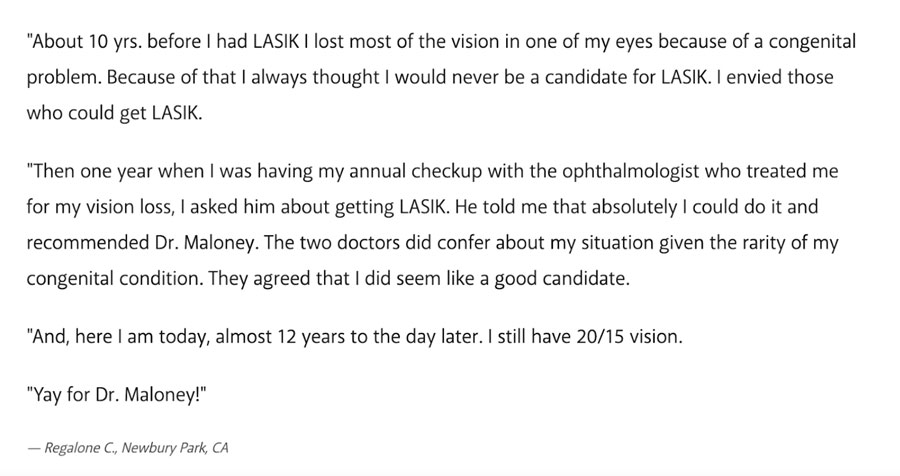
Source: Best LASIK Surgery In Los Angeles | Testimonials | Dr. Robert Maloney
In the example above, the patient talks about his symptoms, diagnosis, and his outcomes. In Australia, a testimonial that would pass is limited to something like this:

Source: LASIK Eye Surgery
In this example, the patient talks only about her experience and makes no claims related to the surgeon’s qualifications or results.
Fortunately, AHPRA makes it easier to determine which testimonials a refractive surgeon can use on their marketing materials by publishing this decision tree:
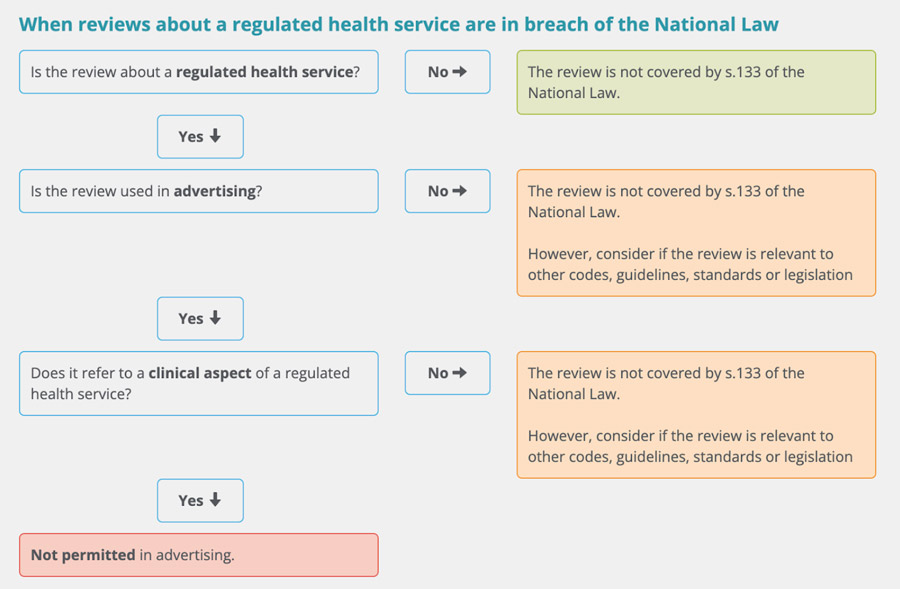
As you can imagine, once all the above elements are omitted from any testimonial, there can be little left. Furthermore, AHPRA does not permit the editing of testimonials.
It also means that when asking for a testimonial, you must give the patient strict guidelines on what they can and cannot mention. The latter may result in a slightly rigid and unnatural testimonial.
A potential solution to this is to ask the patient to focus on their emotional journey, and how they felt they were treated by the staff and the clinic, rather than the procedure itself.
5. Claims related to superior technology
Moorfields Private Eye Hospital claims that they offer

Whether its safety and results are better or not, most refractive surgeons would agree that the latest generation of laser eye surgery technology is lenticule extraction. Yet, Moorfields doesn’t support their claim of “the latest laser eye surgery technology” with evidence or mention lenticule extraction.
Best Ophthalmologist San Antonio TX – Oday Alsheikh MD Braverman-Terry-OEI claims an oft-touted assertion related to “best LASIK surgeons” and “superior LASIK technology”.
When reading this claim, one must ask oneself, “best” according to whom? “Superior” compared to what?
Incidentally, the page title is “Best Ophthalmologist”, which is also an unsubstantiated claim.

6. Claims related to personal attributes
The ASA publishes a series of examples to show how they handled different complaints about eye surgery companies.
One ruling I thought I’d explore in more detail is the case where consumers objected to an Optical Express advertisement that ASA has not upheld:
- “A TV ad for Optical Express, seen in October 2017, promoting Laser Eye Surgery, which featured eight people describing how they felt when wearing glasses. The voice-overs stated, “Frustrated. Unattractive. Tired. Old. Restricted. Fuzzy. Fed up … I hated glasses.” On-screen text stated, “We asked our patients how they felt before and after eye surgery”. The patients’ voice-overs then stated, “So now I feel happy. Free of irritation. Sophisticated. Hassle free. Amazing. Relieved. Confident. Free and Fabulous.” On-screen text stated, “Optical Express also sell a full range of glasses and contact lenses” and “Laser eye surgery from £595 per eye Search ‘Optical Express’ to book your FREE consultation”..
The ASA received eight complaints about this advertisement
- Eight complainants, who believed that the ad implied that wearing glasses was ugly and unattractive, challenged whether the ad was offensive;
- Four of the complainants, who were also concerned that the ad would have a detrimental impact on the self-esteem of children who wore glasses, challenged whether the ad was irresponsible and likely to cause harm to children.
You can read a full description of Optical Express’s response to the claim in the ASA ruling document.
Notably, Facebook will often disallow advertisements that violate the Personal Attributes policy. That policy states:
“Ads must not contain content that asserts or implies personal attributes. This includes direct or indirect assertions or implications about a person’s race, ethnicity, religion, beliefs, age, sexual orientation or practices, gender identity, disability, physical or mental health (including medical condition), vulnerable financial status, voting status, membership in a trade union, criminal record or name.
That means that Facebook will not allow you to say, “Do you have short-sightedness?” But it will allow you to say, “Shortsightedness treatment available”.
Who regulates refractive surgery advertising?
In the UK, the Advertising Standards Authority (ASA) publishes specific advice for eye surgery advertisers and regulates eye surgery advertising.
The European Advertising Standards Alliance (EASA) is the single authoritative voice on advertising self-regulation issues in Europe. It publishes its guidance for self-regulation in it’s Blue Book. Unfortunately, it charges 350-450 euros to obtain access to this resource. In our experience, France’s rules are the most strict (i.e. eye surgeons have not been able to advertise). However, the ban on advertising by doctors was repealed in 2017 by decree in order to comply with European Law.
The Australian Health Practitioners Regulation Agency (AHPRA) has extensive resources on eye surgery advertising do’s and don’ts.
In the US, the Federal Trade Commission (FTC) publishes Guidance for Eye Care Providers.
The most common guidance from regulatory bodies with enforcement powers
To protect consumers, watchdog organisations make it easy for anyone to complain about advertising. Mostly, consumers use these tools when they feel that advertising attempts or is able to mislead them. In other cases, competitors use these tools to attempt to water down your claims.
Furthermore, these organisations publish guidelines for advertisers so that they can avoid complaints.
For example, in it’s guidance, the UK ASA cautions refractive surgery marketers to:
- avoid claiming the procedure “corrects” but not “cures” patients’ sight.
- avoid implying that recovery from laser eye surgery will be immediate.
- Avoid claiming that laser surgery is completely safe or free from side effects: all medical procedures have some, albeit sometimes small, risk.
- be careful when making claims about how advanced or innovative their procedures are.
- remember that if they make comparative claims, they need to hold comparative evidence and ensure this is verifiable.
In the US, the Federal Trade Commission (FTC) Act regulates the advertising and marketing of food, drugs, devices and services. The primary role of this law is to protect consumers from misleading practices that could result in financial loss or coercion when purchasing goods such as cigarettes with nicotine mixed inside them for example. Additionally, it prohibits disseminating false advertisements which can lead people into believing something else than what they were actually promised so there’s little chance you’ll see any ads promoting everything being “perfectly fine” even if things aren’t working correctly.
According to the FTC page on Marketing of Refractive Eye Care Surgery: Guidance for Eye Care Providers:
An ad is deceptive under Section 5 of the FTC Act if it has a statement – or omits information – that:
- is likely to mislead consumers acting reasonably under the circumstances; and
- is “material” – that is, important to a consumer’s decision to buy or use the product.
An ad or business practice is unfair if:
- it causes or is likely to cause substantial consumer injury that a consumer could not reasonably avoid; and
- The injury is not outweighed by any benefit the practice provides to consumers or competition.
The article specifically includes information on how to communicate marketing claims. For example, they state that:
- A claim included in a patient testimonial needs to be provable (e.g. “the procedure was easy” in a testimonial would need substantiation by the advertiser that there are no complications or side-effects for most patients)
- A claim that omits material facts needs to include them (e.g. an offer of a “free consultation” may mislead consumers if it doesn’t say that provider requires a non-refundable deposit before a health professional determines candidacy for the surgery, if that’s the case)
- A claim must have a “reasonable basis”, or objective evidence, that supports claims about success rates, long-term stability, or predictability of outcome. For example, if an advertiser claims that “clinical studies” backup a particular expected result, then they should be able to provide access to the peer-reviewed evidence published in credible scientific publications supporting the claim.
- A claim that implies patients who are nearsighted with no other vision deficiencies can “throw away their glasses” needs further qualification if this outcome is not common for a significant number of patients.
- Any claims regarding the safety and efficacy of LASIK or any other refractive surgery procedure needs to disclose health risks or limitations.
Non-regulatory bodies (i.e. The UK’s Royal College of Ophthalmologists) provides guidance to its members. They asked LiveseySolar to provide advice for these guidelines when they published the Refractive Surgery Advertising and Marketing Standards. These guidelines go further than what the regulatory bodies suggest, including discouraging surgeons to carry out practices including:
- Using celebrity endorsements without disclosing financial relationships that might create a conflict of interest
- Time-limited offers
- Package deals, such as “buy one get one free” or reduced prices for friends and family
- Offering eye surgical procedures as competition prizes
- Advertising price without disclosing eligibility criteria, specific details regarding the provided treatment included, and noting that actual pricing may vary significantly based on the advertised price
- Being inconsistent between marketing materials and information surgeons supply to patients when getting informed consent
- Exaggerating or misleading the public about a surgeon’s qualifications and experience
The Refractive Surgery Alliance also issues Marketing Guidelines to support the growth of refractive surgery and the growth of every member’s practice. The RSA requests all members to abide by the following principles:
- Remove discussions that compare or recommend specific technologies from your web page main “home page”, radio ads, and other ads that discuss refractive surgery. Limit any descriptions of technology to discuss benefits and appropriate use of that technology without reference to other technologies. Any mention of specific technologies should not position one technology as superior to another, since there is no technology that is best for all patients.
- Re-frame your messaging around patient benefit. Market research shows that patients are not interested and/or alarmed by technology messaging. We believe that marketing patient benefits are what will drive growth in refractive surgery.
- Limit or avoid marketing price and discounts. In particular, bait-and-switch advertising for low prices that are seldom the actual price, or saying a price is discounted for a limited time when it is not, are considered de facto violations of the RSA marketing guidelines.
- Avoid negative advertising. While it is expected that practices will showcase their accomplishments and differentiation, marketing should avoid statements that disparage other refractive surgery centers.
We at LiveseySolar stand fully aligned with these principles.
What is acceptable evidence of a claim?
To avoid misleading the public, you should support claims made in your advertising with acceptable evidence.
As an example, AHPRA assesses evidence as ‘acceptable’ where a body of evidence rates highly against the following factors:
- Source: Is the evidence supporting my claim from a publicly accessible and reliable source?
- Relevance: Does the evidence directly support my advertising claim? Is it about the patient population targeted by my claim?
- Inclusion: Have I considered relevant studies on this topic, including negative and neutral findings?
- Level: Was the study well-designed and appropriately selected to answer the research question/s?
- Quality: How was the study conducted? How much uncertainty is there? Have chance, bias and confounding factors been considered?
- Strength: Does the evidence show a meaningful effect that supports my advertising claim?
You can use the framework above when making or assessing advertising claims about the benefits or effectiveness of treatment.
You can also consider the evidence level pyramid to help you navigate through the different levels of evidence:
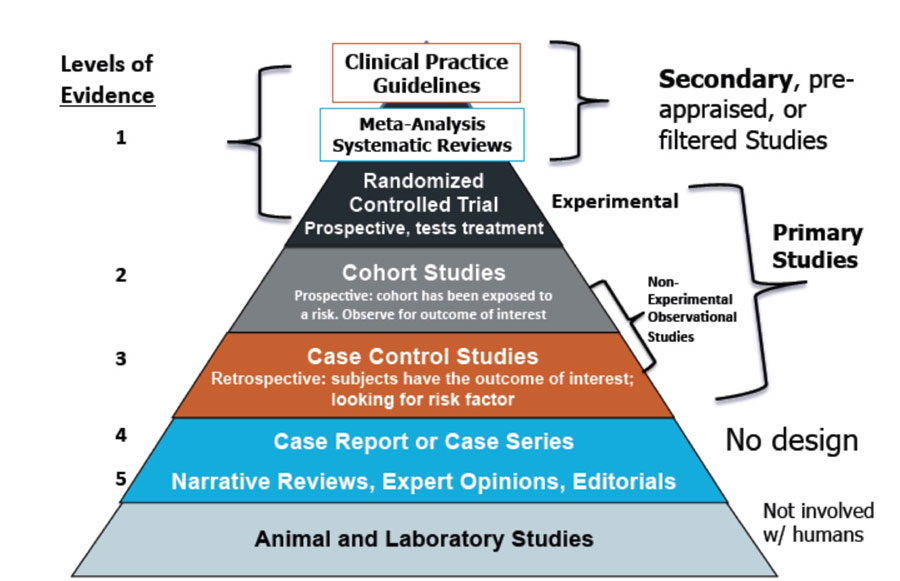
What if you can’t back up a claim with acceptable evidence?
If you want to produce engaging marketing material that engages your target audience and won’t result in a financially crippling lawsuit, take a look at the handy tips and tricks we’ve applied to some real-life examples below.
Examples, tips and tricks
| Non-compliant copy | New compliant copy | What we did |
|---|---|---|
| The company provides outstanding care and results for every patient. | The company aims to provide the best possible care and results for every patient. | Avoid definitive language. Instead, use words that demonstrate your intent.
For example: Aims to, pursues, seeks to, intends to, wants to, aspires to, endeavours to, strives to |
| We use technology that makes the treatment safer, more comfortable and more precise. | We use the latest technology and techniques to achieve the best result possible for your eyes. | Avoid risky words: Using words like ‘safer’ and ‘more precise’ are comparative and require evidence to support superiority. Replace them with words that are softer and more open to interpretation. |
| …we will then recommend one of the following procedures that will help you see clearly without glasses or contact lenses. | …we will recommend one of the following procedures with the aim of reducing or eliminating your dependence on glasses. | Don’t over-promise. Instead, set realistic expectations by communicating honestly. |
| With LASIK, you can have 20/20 vision without the need for visual aids – gain that feeling of total freedom. | Imagine having 20/20 vision without the need for glasses and contact lenses – that feeling of total freedom. | Paint a picture. If you want to excite your patients without guaranteeing a certain result, use words and phrases to help the reader get in touch with hopes and aspirations. |
After LASIK:
|
After LASIK, you should expect to...
|
Use modal verbs. A modal verb is a type of verb that is used to indicate modality – that is the likelihood of something occurring. Some effective modal verbs include, should, would, could, can, may, and might. |
| After lens replacement, everything becomes vibrant and visible… | After lens replacement, we’re confident your worldview will be more vibrant and visible. | Use optimistic words.
E.g. we’re hopeful, optimistic, assured, expectant, convinced. |
| …and you’ll be able to appreciate life’s finer details once again. | Our patients can often appreciate life’s finer details once more. | Use adverbs to suggest frequency and probability.
E.g. repeatedly, again and again, time and again, in many instances, frequently. |
Are you making dangerous or borderline marketing claims?
The key points to take away from this article are
- To know the difference between express, implicit, and subjective claims
- To recognise the different types of marketing claims we typically observe in refractive and cataract surgery marketing
- To understand where to access regulations for the substantiation of marketing claims, and
- To understand what constitutes an acceptable level of substantiation for your marketing claim.
It is important to present your claims in a way that remains within legal limits while still being interesting and engaging for your audience. We hope these pointers will help you create more effective advertising copy and content!
If you have any concerns about how best to use these guidelines or if you need additional information on refractive and cataract surgery marketing please schedule a quick chat with us today.
Acknowledgement: I’d like to thank Elisa Friedl, Nicola Azzopardi, and Jemima Owen-Jones for their suggestions and contributions to this post.
About the author
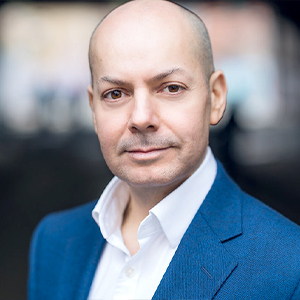
Rod Solar
Founder & Scalable Business Advisor / fCMO
Rod Solar is a co-founder of LiveseySolar and a Scalable Business Advisor for its customers. Rod mentors and coaches eye surgery business CEOs/Founders and their leadership teams to triple their sales, double their profit, and achieve their “ideal exit”.
Related Posts
Meet our Founders

Rod Solar
Founder & Scalable Business Advisor
Rod Solar is a co-founder of LiveseySolar and a Scalable Business Advisor / fCMO for our customers. Rod mentors and coaches CEOs/Founders and their leadership teams to triple their sales, double their profit, and achieve their “ideal exit”.
LiveseySolar completely transformed the way we were approaching this… We’ve gone from having just the dream of having a practice to having a practice up and running with people making inquiries and booking for procedures… It’s extremely pleasing. We feel lucky we connected with LiveseySolar.
— Dr Matthew Russell, MBChB, FRANZCO, specialist ophthalmic surgeon and founder of VSON and OKKO

Laura Livesey
Founder & CEO
Laura Livesey is the co-founder & CEO of LiveseySolar. She has developed powerful refractive surgery marketing systems that increase patient volumes and profits for doctors, clinics, and hospitals, since 1997.
Rod and Laura know as much about marketing surgery to patients as I know about performing it. They are an expert in the field of laser eye surgery marketing. They know this industry inside out. I believe that they could help many companies in a variety of areas including marketing materials, sales training and marketing support for doctors.
— Prof. Dan Reinstein, MD MA FRSC DABO, founder of the London Vision Clinic, UK






